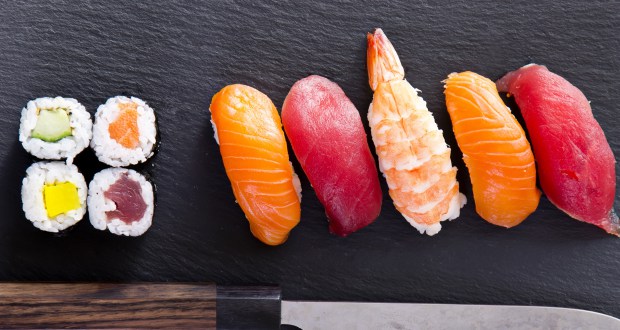
This once ‘exotic’ dish has become quite popular among the health conscious as it is seen as a healthy alternative to other restaurant meals. This is largely based on the protein and omega-3 content of the raw fish used in making the different types of sushi, and the fact that people tend to eat less of it as it can be extremely satiating.
However, the generally recommended intake of oily fish is 140g per serving, eaten at least twice a week. While sushi is a tasty way to get in one or more of these servings, each individual portion contains very little protein – about 5g.
You’d therefore need to eat roughly 28 pieces of sushi to reach 140g, which leads to another problem…
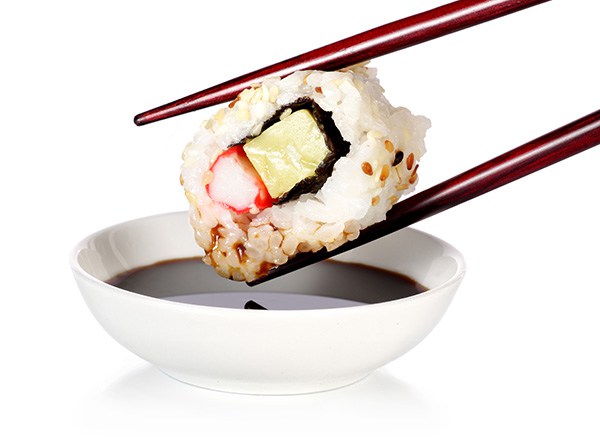
The stodgy white rice used in most sushi rolls, which can account for as much as 75% of the dish, is heavily processed and is a high glycaemic index (GI) carbohydrate. Because the rice is processed it is also devoid of vitamins, minerals and fibre, and also contains considerable amounts of sugar and sugary rice vinegar for flavour.
This means it is far from the healthiest ingredient.
And as sushi becomes more popular, restaurants have started to compete on price rather than quality, which means the cheapest ingredients are now often used – and in larger quantities. Obviously to give customers more bang for their buck more rice is used to plump up rolls, which pushes up the calorie content of each dish, many of which are hollow calories.
And don’t be fooled into thinking that ordering more sashimi is a better option. A recent study published in the Journal of Risk Research found that the highest level of methyl-mercury (a toxic compound that forms when mercury binds with organic molecules in the environment) can be found in tuna, shark, swordfish and marlin. Tuna sashimi contains the highest level of methyl-mercury, where sushi made with eel, crab, salmon and kelp have much lower levels. You therefore still need to moderate your intake.
But it is not all bad news for sushi lovers. Sushi is always served with a side of ginger and wasabi, which act as more than garnish. Ginger delivers plenty of potassium, magnesium, copper, and manganese, while wasabi is packed with antioxidants such as isothiocyanates.
The trick to still enjoying a regular sushi meal without all the drawbacks is being mindful and knowing what goes into each roll.
To help improve your sushi orders, here are the general calorie contents of the more popular dishes:
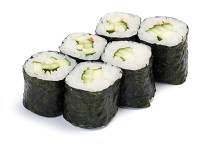
Cucumber roll
Ingredients: Rice, cucumber and nori 136 calories
0 g fat
6 g protein
3.5 g fibre
30 g carbohydrates
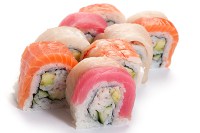
Rainbow roll
Ingredients: Nori, rice, avocado, surimi, raw fish (on the outside)
476 calories
16g fat
33g protein
6 g fibre
50 g carbohydrates
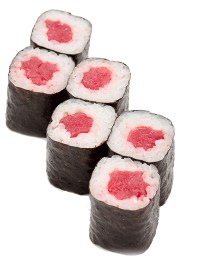
Avo roll
Ingredients: Nori, rice, avocado 140 calories
5.5 g fat
2g protein
6g fibre
28g carbohydrates
Tuna maki
Ingredients: Nori, rice, tuna 184 calories
2g fat
24g protein
3.5g fibre
27g carbohydrates
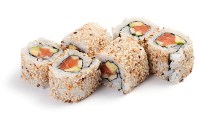
California roll
Ingredients: Nori, rice, avocado, surimi 255 calories
7g fat
9g protein
6g fibre
38g carbohydrates
Try our top tips when ordering your next sushi meal
If maki is one of your favourite choices limit them to two rolls. And ask for brown rice if it’s available, not necessarily for the extra fibre, but for the whole grains which protect your heart.
Anything tempura is a no go because they’re battered and deep-fried, which adds to the calorie, fat and carb content.
Limit rainbow and spicy tuna rolls due to their high calorie content, and be weary of too many eel rolls. While they taste great and are packed full of healthy omega-3s, most places tend to serve them in a sugary brown sauce that offers no nutritional value, just added calories.
For lower calorie options choose tuna, yellow tail, shrimp or salmon rolls.
For extra flavour and fewer calories try adding scallions or cucumbers to your sushi. And order more veggie rolls like those with spinach, avocado or shiitake mushrooms.
